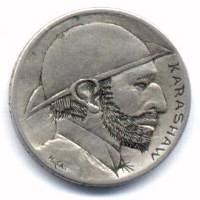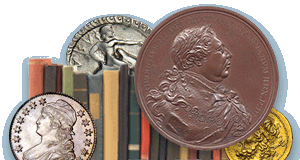
PREV ARTICLE
NEXT ARTICLE
FULL ISSUE
PREV FULL ISSUE
V11 2008 INDEX
E-SYLUM ARCHIVE
STEPHEN P. ALPERT ARTICLE: A SIBERIAN 3-SIDED HOBO NICKEL
The Alaskan Token collector newsletter reprinted a
fascinating article by Stephen P. Alpert. It was originally published by
the Original Hobo Nickel Society. With permission, I'm publishing some
excerpts here. The full article is available on the OHNS web site (see
link below). The title is " A Siberian 3-sided Hobo Nickel" -Editor
 Sounds bizarre, doesn't it? But that is what I obtained from
an ebay auction just after our January 2004 OHNS meeting in Orlando.
Besides being a high-quality carving with attractive hand lettering on
both sides, and on the edge (that's the seldom-altered third side of a
hobo nickel, folks), the piece is just smothered and dripping with
history. And military history, no less. First, a description of this
totally-carved old hobo nickel. The obverse has the standard design
alteration - a bearded man wearing a derby. Here we have a nice plain
derby, with a pointy-ended wrap-around brim, no hat band, and a nice
smoothly-dressed large dome. A nice ear, with internal detail and an
earlobe, overlaps the hat brim. The hair-beard-mustache is beautifully
hand engraved. The eye is altered, as are the nose and lips.
Sounds bizarre, doesn't it? But that is what I obtained from
an ebay auction just after our January 2004 OHNS meeting in Orlando.
Besides being a high-quality carving with attractive hand lettering on
both sides, and on the edge (that's the seldom-altered third side of a
hobo nickel, folks), the piece is just smothered and dripping with
history. And military history, no less. First, a description of this
totally-carved old hobo nickel. The obverse has the standard design
alteration - a bearded man wearing a derby. Here we have a nice plain
derby, with a pointy-ended wrap-around brim, no hat band, and a nice
smoothly-dressed large dome. A nice ear, with internal detail and an
earlobe, overlaps the hat brim. The hair-beard-mustache is beautifully
hand engraved. The eye is altered, as are the nose and lips.There is a simple collar with a jewel at front. The shoulder-coat area below only has the date erased, and the small letters "H.C.A." engraved below. I take this to be the signature initials of the artist. The obverse field is smoothly dressed, with Liberty removed. Around the right is engraved the name "KARASHAW" which I assume is someone's last name, possibly the person depicted on the carving.
 The reverse has the buffalo nicely altered into a donkey. All
the coin's wording has been removed, and the field nicely dressed for the
new hand-engraved legends: "BOLSHEVIKI" around the top, "1919" in front of
the donkey, and "10 KOPEKS" where Five Cents used to be.
The reverse has the buffalo nicely altered into a donkey. All
the coin's wording has been removed, and the field nicely dressed for the
new hand-engraved legends: "BOLSHEVIKI" around the top, "1919" in front of
the donkey, and "10 KOPEKS" where Five Cents used to be.It turns out that this piece is from what is referred to as "America's Secret War" when American forces intervened in the Russian Revolution. This was the first and only time American troops operated on Russian soil. Below, briefly, is the story of the U.S. Intervention in Siberia, 1918 to 1920, gathered from the Internet (where you can find a whole lot more information on this operation).
During the Russian Revolution, Japan was about to send 7,000 soldiers to Vladivostok. In conjunction, President Wilson also sent 5,000 to 7,000 (figures vary) U.S. soldiers, so Japan wouldn't gain a stronghold there. The purpose of deploying US forces there was threefold: 1) To guard the military supplies that we previously sent there (600,000 tons of war material and about a billion dollars worth of guns and equipment), that were just sitting around inadequately guarded. 2) To secure the eastern end of the Trans Siberia Railway. 3) To stabilize the area during the Russian Revolution.
So an American Expeditionary Force (A.E.F. on the edge of the hobo nickel) was sent to Siberia, comprised mostly of the U.S. Army's 27th and 31st Infantry Regiments (31 INF. is on the edge of the hobo nickel).
One Aug. 16, 1918, 1590 US troops from the 27th Inf. Arrived in Vladivostok, followed by 1421 troops from the 31st Inf. On Aug. 21. More arrived from the 8th Inf. Div. later. The 31st Inf. operated in the area just north of Vladivostok and in the small mining town of Suchan.
Note that the inscribed edge of the hobo nickel begins with "HDQTS. CO." which may indicate that the person who carved this hobo nickel worked in the Headquarters or Headquarters Company of this unit.
This is the best-documented or only U.S. "trench art" soldier-carved hobo nickel I know of. It is also the only three-sided hobo nickel known to me. Thus it is probably the most fascinating hobo nickel in my entire collection.
To read the complete article, see: A Siberian 3-sided Hobo Nickel (http://www.hobonickels.org/siberia.htm)
Wayne Homren, Editor
The Numismatic Bibliomania Society is a non-profit organization promoting numismatic literature. See our web site at coinbooks.org.
To submit items for publication in The E-Sylum, write to the Editor at this address: whomren@gmail.com
To subscribe go to: https://my.binhost.com/lists/listinfo/esylum
All Rights Reserved.
NBS Home Page
Contact the NBS webmaster
